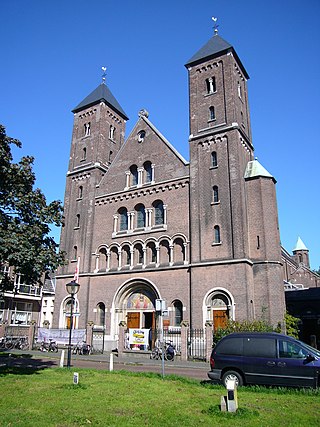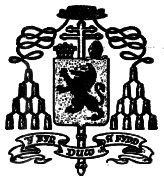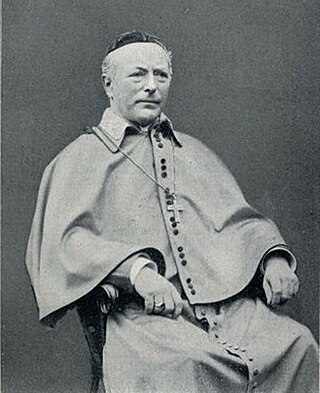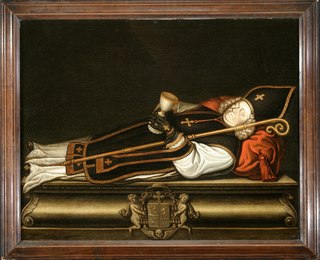Related Research Articles
The terms Old Catholic Church, Old Catholics, Old-Catholic churches, or Old Catholic movement, designate "any of the groups of Western Christians who believe themselves to maintain in complete loyalty the doctrine and traditions of the undivided church but who separated from the see of Rome after the First Vatican council of 1869–70".

The Old Catholic Church of the Netherlands, sometimes Jansenist Church of Holland, is an Old Catholic jurisdiction originating from the Archdiocese of Utrecht (695–1580). The Old Catholic Church of the Netherlands is the mother church of the Old Catholic Union of Utrecht.
Independent Catholicism is an independent sacramental movement of clergy and laity who self-identify as Catholic and form "micro-churches claiming apostolic succession and valid sacraments", in spite of not being affiliated to the historic Catholic church, the Roman Catholic church. The term "Independent Catholic" derives from the fact that "these denominations affirm both their belonging to the Catholic tradition as well as their independence from Rome".

The Union of Utrecht of the Old Catholic Churches, most commonly referred to by the short form Union of Utrecht (UU), is a federation of Old Catholic Churches, nationally organized from schisms which rejected Roman Catholic doctrines of the First Vatican Council in 1870; its member churches are not in communion with the Roman Catholic Church.

Arnold Harris Mathew, self-styled de jure 4th Earl Landaff of Thomastown, was the founder and first bishop of the Old Roman Catholic Church in the United Kingdom and a noted author on ecclesiastical subjects.

Gerardus Gul served as the seventeenth Archbishop of Utrecht from 1892 to 1920. He is known for his role in assisting the persons who would later found the Polish National Catholic Church in the United States, as well as for consecrating Arnold Harris Mathew, the founder and first bishop of the Old Catholic Church in Great Britain.

The Lordship of Utrecht was formed in 1528 when Charles V of Habsburg conquered the Bishopric of Utrecht, during the Guelders Wars.

Dominique-Marie Varlet was a French prelate and missionary of the Catholic Church who served as vicar general of the Diocese of Quebec. Later, as the Roman Catholic Bishop of Babylon, he was involved in a schism within the Roman Catholic Church by consecrating four men successively as Archbishop of Utrecht.

The Old Catholic Archdiocese of Utrecht is an archdiocese within the Old Catholic Church of the Netherlands which split from the Archdiocese of Utrecht officially in 1723 because of the illicit consecration of Cornelius van Steenoven to the episcopate.

Cornelis van Steenoven was a Dutch Roman Catholic priest who later served as the seventh Old Catholic Archbishop of Utrecht from 1724 to 1725. Consecrated without the permission of the pope, Steenoven was at the center of the 18th-century controversy between national churches and what many considered to be the overreaching powers of the papacy.
Cornelius Johannes Barchman Wuytiers served as the Old Catholic Archbishop of Utrecht from 1725 to 1733.

Theodorus van der Croon (1668–1739) served as the ninth Archbishop of Utrecht from 1734 to 1739.

Petrus Johannes Meindaerts served as the tenth Archbishop of Utrecht from 1739 to 1767. After the death of his consecrator, Bishop Dominique Marie Varlet, Meindaerts consecrated other bishops, such that all later Old Catholic bishops derive their apostolic succession from him, as the bishops before him died before they could consecrate others.

Walter Michael van Nieuwenhuisen served as the eleventh Archbishop of Utrecht from 1768 to 1797.
Johannes Jacobus van Rhijn served as the twelfth Archbishop of Utrecht from 1797 to 1808.
Willibrord van Os served as the thirteenth Archbishop of Utrecht from 1814 to 1825.
Johannes van Santen served as the fourteenth Archbishop of Utrecht from 1825 to 1858. He was part of the last attempt of the Church of Utrecht to reconcile with the Roman Catholic Church at that time.

Johannes Heykamp served as the sixteenth Archbishop of Utrecht from 1875 to 1892. A learned theologian, Heykamp is most remembered for summoning the conference that led to the Declaration of Utrecht.
Franciscus Kenninck served as the eighteenth Archbishop of Utrecht from 1920 to 1937.

Andreas Rinkel was a Dutch priest who served as the nineteenth Archbishop of Utrecht from 1937 to 1970.
References
- ↑ Moss, p. 241.
Moss, C.B. (1948). The Old Catholic Movement: Its Origins and History. Berkeley, CA: The Apocryphal Press. ISBN 9780976402596.
dfsf sd<zsds